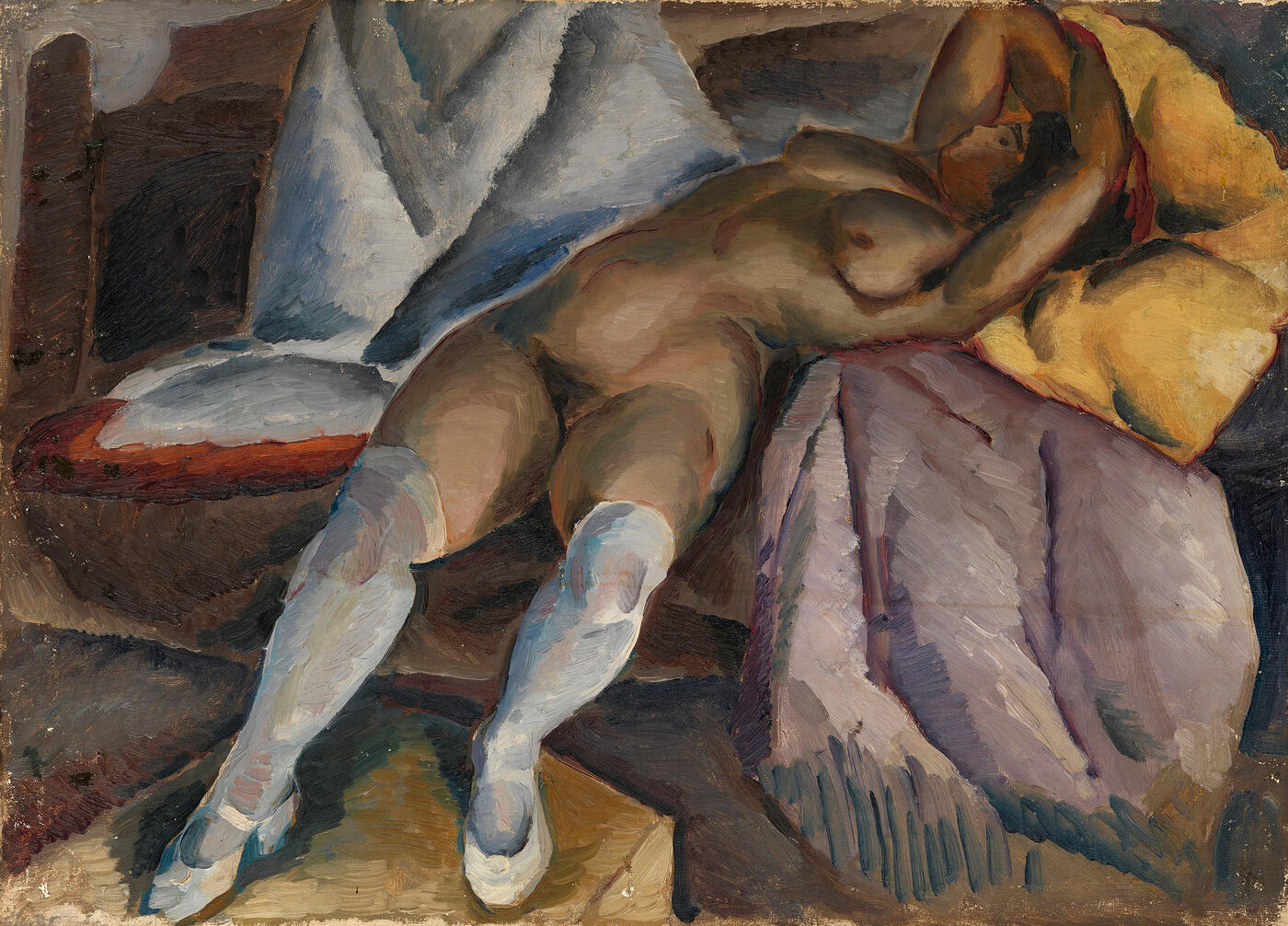MacDougall's Russian Art Auctions 27-30 May 2012
27 May 2012

35. KRAVCHENKO, ALEKSEI (1889-1940)
Reclining Nude .
Oil on canvas, 48.5 by 66.5cm.
300,000–500,000 GBP
Painted in 1919.
Provenance: Collection of the artist’s family.
Anonymous sale; Russian Art Evening, Sotheby’s London, 26 November 2007, Lot 54.
Private collection, UK.
The nude figure was an integral part of Alexei Kravchenko’s creative work for more than
twenty years. Having chosen this motif for his creative framework, the artist experimented with colour, texture and composition throughout the duration of his life. Of particular interest in this regard are Kravchenko’s works of the late 1910s and early 1920s, when the quest for a style of his own in the torrents of the 20th century avant-garde led the artist to create a whole cycle of large nudes, with the common theme of sleep running through them.
One of the first such works was the present composition, Reclining Nude, painted in 1919. In this painting the direct influence of the artistic principles of Cézanne can still be felt – a tendency towards constructiveness and the juxtaposition of planes. In devising the composition of his nude, Kravchenko is seeking new ways of portraying the interaction between the
figure and space, between the figurative expression of a human and an interior. Though he had under his belt classical training from the Moscow School of Painting, Sculpture and Architecture; experience of studying in the studios of V. Serov, K. Korovin and A. Vasnetsov; the I. Levitan prize and high praise from I. Repin, Kravchenko still comes through in this work not as a follower of the Moscow school of painting, but rather as an accomplished artist who is part of the culture of contemporary European art.
In Reclining Nude the influence can also be felt of Kravchenko’s experience training at Simon
Hollosy’s school in Munich, and his personal stylistic inclinations of this time. In addition to the painting offered here at auction, numerous life drawings of nude models are known from this period. It is quite clear from these that Kravchenko knew how to simply but effectively place his model, that he enjoyed and had a feel for it. He constantly changes the medium he is drawing in – charcoal, Indian ink, crayon, pastel. He studies the anatomy and sculptural nature of the human body in the widest variety of different poses, movements,
twists and turns. The models frequently make the transition from drawings to later emerge in paintings.
For all the artist’s love of working from life and his almost daily sessions of drawing nudes, in the majority of these nudes painted in the late 1910s there is a sense of artificiality to the composition and retrospection to other works of art. Reclining Nude is no exception. In the
woman’s pose, her hands behind her head, her white stockings and shoes, one can see an allusion to Delacroix’s Woman with White Stockings and numerous reworkings of this rather popular subject in art history – from Repin’s to Picasso’s to Renoir’s and many other similar canvasses. What comes across from the painting with its sustained bright, warm tones is the colour and light of a sunny morning, in the sound of a major chord. The composition is interesting: the broken curve of the naked body freed from its coverings divides the plane of the canvas into two practically equal portions, in which the cut-off triangle of white pillows at the foot of the bed is counterbalanced by the rumpled pink coverlet that has slipped to the floor.
The linear solutions Kravchenko used in the 1910s to render three-dimensional nudes are replaced in Reclining Nude by a technique of counterposing contrasting planes that fracture the space to create a state of expressive tension. The artist’s palette consists of gradations of four main colours (white, pink, yellow and ochre). Modelling of the forms is laconic, with a generalised design and a strictly calibrated rhythm. Here everything is surprisingly sculptural – the folds of the bedclothes and pillows, and even the compositionally superfluous parallelepiped footstool on which the model’s legs are resting in their elegant white shoes and stockings.
Soon after he completed Reclining Nude, Kravchenko turned to the triptych Awakening for a mural he was commissioned to paint in the early 1920s. Here, as in Reclining Nude, he found expression not only for his explorations in figurative art, but also for his constant reflections on the problem – which preoccupied the artist over these years – of sleep, the continuity of life and dreams.
Notes on symbols:
* Indicates 5% Import Duty Charge applies.
Ω Indicates 20% Import Duty Charge applies.
§ Indicates Artist's Resale Right applies.
† Indicates Standard VAT scheme applies, and the rate of 20% VAT will be charged on both hammer price and premium.